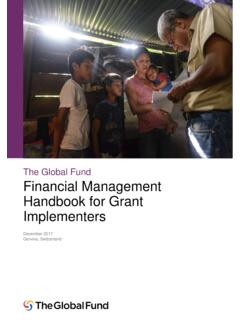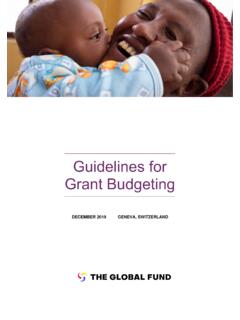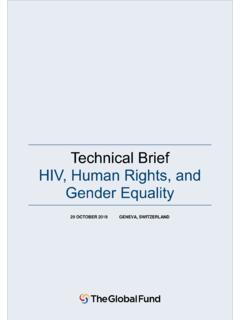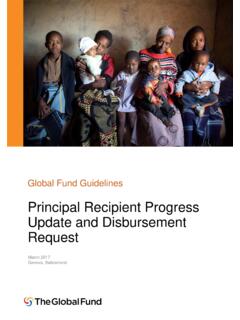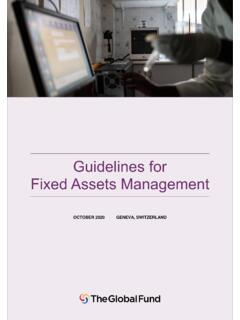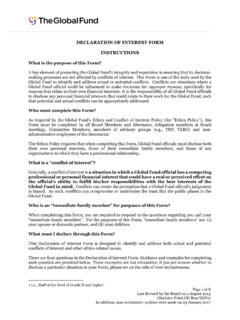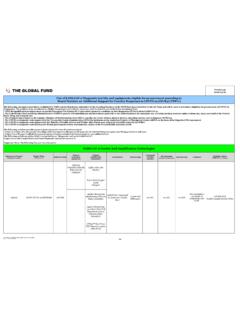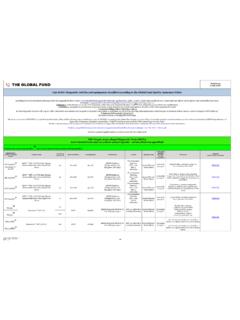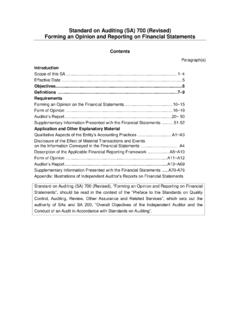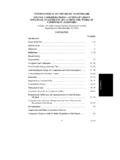Transcription of Guidelines for Annual Audit of Global Fund Grants
1 Geneva Switzerland NOVEMBER 2019 GENEVA, SWITZERLAND CLICK HERE TO ENTER HIGHLIGHT HEADING CLICK HERE TO ENTER HIGHLIGHT TEXT Click to select, then choose image or delete for no image Guidelines for Annual Audit of Global Fund Grants This page has been intentionally left blank Contents GLOSSARY .. 5 1 INTRODUCTION .. 7 BACKGROUND .. 7 PURPOSE .. 7 KEY PRINCIPLES .. 7 2 TYPES AND SCOPE OF AUDITS AND financial ASSURANCE ENGAGEMENTS FOR Global FUND Grants .. 9 financial Audit .. 9 The special Purpose Grant financial Statement (SPGFS) Audit .. 9 Program Audit .. 9 Implementer statutory financial Audit .. 10 PERFORMANCE Audit .
2 10 SYSTEMS Audit .. 11 LIMITED REVIEW .. 11 ASSET SAFEGUARD ENGAGEMENT .. 11 FRAUD-RELATED ENGAGEMENTS .. 12 OTHER SPECIFIC SITUATIONS .. 12 Grant 12 Audit of Grants involving Common Funding Mechanisms (CFM) .. 12 Audit of Grants involving headquarters (HQ)-generated expenditures .. 13 Exceptional cases of United Nations-affiliated organizations .. 13 Audit of Grants using different funds channeling models (Innovative Financing) .. 13 Single Audit principle .. 13 3 Audit SCOPE AND RISK-BASED DIFFERENTIATED APPROACH .. 15 GRANT CONSOLIDATED Audit , OR GRANT-SPECIFIC Audit AT SR LEVEL .. 15 RISK LEVEL DETERMINATION .. 15 Audit PACKAGE (RISK-BASED MATRIX).
3 16 Standard Audit package .. 16 Tailored Audit package .. 16 Audit TERMS OF REFERENCE (TORS) .. 17 4 AUDITOR SELECTION AND ACCREDITATION .. 18 TYPE OF AUDITOR FOR Global FUND Grants .. 18 Government Supreme Audit Institutions (SAIs) .. 18 Corporate or institutional auditors .. 18 Contractual auditors .. 18 Regional Auditor .. 19 AUDITOR SELECTION AND ACCREDITATION .. 19 Minimum requirements for grant s auditors .. 19 Approval procedures .. 19 APPOINTMENT OF THE AUDITOR .. 20 AUDITOR PERFORMANCE ASSESSMENT, ROTATION AND TERMINATION .. 21 Audit FEES .. 21 5 ACCOUNTING FRAMEWORK AND financial STATEMENTS OF financial Audit .. 22 ACCOUNTING FRAMEWORK AND special PURPOSE GRANT financial STATEMENTS.
4 22 Accounting Principles, Policies and Basis .. 22 Preparation of the Principal Recipient s financial Statements .. 22 special Purpose Grant financial Statements for financial Audit .. 22 Specific case of direct payment to a third party .. 23 6 AUDITING AND ASSURANCE ENGAGEMENT STANDARDS .. 24 7 Audit REPORT AND OPINIONS .. 25 GRANT SPECIFIC financial Audit .. 25 SYSTEMS Audit .. 26 PERFORMANCE Audit .. 26 8 SUBMISSION AND REVIEW OF THE Audit REPORT .. 27 Audit REPORTING CYCLES .. 27 DUE DATE .. 27 FORMAT OF 27 REVIEW AND APPROVAL OF AUDITED financial STATEMENTS .. 27 28 9 ROLES AND RESPONSIBILITIES .. 29 CCM .. 29 PRINCIPAL 29 THE LOCAL FUND 29 THE Global FUND SECRETARIAT.
5 29 November 2019 Geneva, Switzerland Page 05 Glossary Cash Accounting A method of accounting that recognizes receipts and payments in the financial statements when cash is received, and cash is paid out, respectively. Accrual Accounting Under accrual accounting the revenue or income is recorded when it is earned, and expenditure is recorded when it is incurred1 irrespective of the dates in which any associated cash flows occur. Modified Cash Accounting It combines cash accounting with accrual accounting. Under modified cash accounting: income and expenditure are recognized or accounted for using a cash basis; short-term financial statement items (current assets and current liabilities) are recognized or accounted for using a cash basis; and long-term financial statement items (non-current assets and liabilities) are recognized or accounted for using an accrual basis.
6 Modified Accrual Accounting It combines the accrual accounting with the cash accounting, under modified accrual accounting: income/revenue is recognized/accounted for using a cash basis; expense/expenditure are recognized/accounted for using accrual basis; short-term financial statements items (current assets and current liabilities) are recognized/accounted for using accrual accounting; and long-term financial statements items (noncurrent asset and liabilities) are recognized/accounted for using a cash accounting basis. Accounting Principles Accounting principles are a set of rules, standards and Guidelines used by an organization for the recording and reporting of financial information.
7 They define the bases by which the transactions, assets and liabilities are valued and presented in the financial statements. Accounting Policies Accounting policies are the specific principles, bases, conventions, rules and practices applied by an organization when preparing and presenting financial statements. IFRS International financial Reporting Standards issued by the International Accounting Standards Board (IASB). This Board sets accounting standards globally for the private sector and upon its creation in 2001, it adopted all International Accounting Standards (IASs) which had been previously issued by its predecessor body, the International Accounting Standards Committee (IASC).
8 1 The amount an organization or person has paid or has committed to pay for goods or services received from another organization or person. November 2019 Geneva, Switzerland Page 06 Internal Controls Internal Controls include policies and procedures, geared towards managing key operational risks, financial and non- financial , associated with various Global Fund grant funded activities at Principal Recipient and Sub-recipient levels. INTOSAI The International Organization of Supreme Audit Institutions (INTOSAI) is a Global body comprising Supreme Audit Institutions (or national Audit offices) which issues public sector/government auditing standards to be applied by its members.
9 IPSAS International Public Sector Accounting Standards (IPSAS) are those applicable to public sector/government entities. They are issued by the International Public Sector Accounting Standards Board of IFAC (the International Federation of Accountants). ISAs International Standards on Auditing (ISAs) are developed by the International Auditing and Assurance Standards Board (IAASB) and contain basic principles and essential procedures together with related guidance in the form of explanatory and other material. ISSAI The International Standards of Supreme Audit Institutions (ISSAI) are the professional standards and best practice Guidelines for public sector auditors.
10 Management Letter A document prepared by the auditor for the management of an audited entity highlighting all key findings as a direct consequence of the Audit work performed to form an opinion on the financial statements. It also sets out findings (such as weaknesses in internal controls), implications and recommendations and solicits the response of the audited entity s management to the Audit findings and recommendations. Sub-recipients and Sub-Sub-recipients A Sub-recipient receives grant funds directly from the Principal Recipient of a Global Fund grant and implements certain program activities. The Principal Recipient enters into a written agreement with a Sub-recipient to formalize the terms and conditions and includes the name of the Sub-recipient in the Detailed and Summary Budget of the relevant grant agreement.
